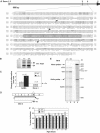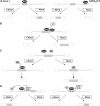Nova autoregulation reveals dual functions in neuronal splicing
- PMID: 15933722
- PMCID: PMC1142566
- DOI: 10.1038/sj.emboj.7600630
Nova autoregulation reveals dual functions in neuronal splicing
Abstract
The Nova family of neuron-specific RNA-binding proteins were originally identified as targets in an autoimmune neurologic disease characterized by failure of motor inhibition. Nova-1 regulates alternative splicing of pre-mRNAs encoding the inhibitory neurotransmitter receptor subunits GABA(A)Rgamma2 and GlyRalpha2 by directly binding intronic elements, resulting in enhancement of exon inclusion. Here we identify exon E4 in the Nova-1 pre-mRNA itself, encoding a phosphorylated protein domain, as an additional target of Nova-dependent splicing regulation in the mouse spinal cord. Nova binding to E4 is necessary and sufficient for Nova-dependent exon exclusion. E4 harbors five repeats of the known Nova-binding tetranucleotide YCAY and mutation of these elements destroys Nova-dependent regulation. Furthermore, swapping of the sites from Nova-1 and GABA(A)Rgamma2 indicates that the ability of Nova to enhance or repress alternative exon inclusion is dependent on the position of the Nova-binding element within the pre-mRNA. These studies demonstrate that in addition to its previously described role as a splicing activator, Nova autoregulates its own expression by acting as a splicing repressor.
Figures








Similar articles
-
Nova regulates GABA(A) receptor gamma2 alternative splicing via a distal downstream UCAU-rich intronic splicing enhancer.Mol Cell Biol. 2003 Jul;23(13):4687-700. doi: 10.1128/MCB.23.13.4687-4700.2003. Mol Cell Biol. 2003. PMID: 12808107 Free PMC article.
-
Nova-1 regulates neuron-specific alternative splicing and is essential for neuronal viability.Neuron. 2000 Feb;25(2):359-71. doi: 10.1016/s0896-6273(00)80900-9. Neuron. 2000. PMID: 10719891
-
Regulatory roles of heterogeneous nuclear ribonucleoprotein M and Nova-1 protein in alternative splicing of dopamine D2 receptor pre-mRNA.J Biol Chem. 2011 Jul 15;286(28):25301-8. doi: 10.1074/jbc.M110.206540. Epub 2011 May 26. J Biol Chem. 2011. PMID: 21622564 Free PMC article.
-
The neuronal splicing factor Nova controls alternative splicing in N-type and P-type CaV2 calcium channels.Channels (Austin). 2010 Nov-Dec;4(6):483-9. doi: 10.4161/chan.4.6.12868. Epub 2010 Nov 1. Channels (Austin). 2010. PMID: 21150296 Free PMC article. Review.
-
Maps, codes, and sequence elements: can we predict the protein output from an alternatively spliced locus?Neuron. 2006 Nov 22;52(4):574-6. doi: 10.1016/j.neuron.2006.11.005. Neuron. 2006. PMID: 17114042 Review.
Cited by
-
Disabled-1 alternative splicing in human fetal retina and neural tumors.PLoS One. 2011;6(12):e28579. doi: 10.1371/journal.pone.0028579. Epub 2011 Dec 6. PLoS One. 2011. PMID: 22163036 Free PMC article.
-
The determinants of alternative RNA splicing in human cells.Mol Genet Genomics. 2017 Dec;292(6):1175-1195. doi: 10.1007/s00438-017-1350-0. Epub 2017 Jul 13. Mol Genet Genomics. 2017. PMID: 28707092 Review.
-
RNA processing and its regulation: global insights into biological networks.Nat Rev Genet. 2010 Jan;11(1):75-87. doi: 10.1038/nrg2673. Nat Rev Genet. 2010. PMID: 20019688 Free PMC article. Review.
-
The Neuronal Splicing Factor Nova Co-Localizes with Target RNAs in the Dendrite.Front Neural Circuits. 2010 Mar 3;4:5. doi: 10.3389/neuro.04.005.2010. eCollection 2010. Front Neural Circuits. 2010. PMID: 20407637 Free PMC article.
-
Discovery and analysis of evolutionarily conserved intronic splicing regulatory elements.PLoS Genet. 2007 May 25;3(5):e85. doi: 10.1371/journal.pgen.0030085. Epub 2007 Apr 13. PLoS Genet. 2007. PMID: 17530930 Free PMC article.
References
Publication types
MeSH terms
Substances
Grants and funding
LinkOut - more resources
Full Text Sources
Molecular Biology Databases

